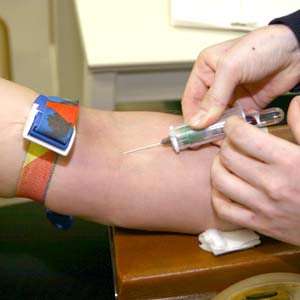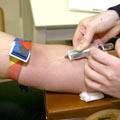Description of the test
Prothrombin and thrombin are proteins found in your blood that are called "clotting factors" because they are necessary for clot formation. The prothrombin time (PT) test measures how long it takes for your blood to clot. Specifically, the test measures how long it takes for prothrombin to turn into thrombin.
By measuring prothrombin time, this test determines if five different blood clotting factors are present in your blood. During the test, a blood sample is taken so that PT can be measured. This test is often used to monitor the effects of anticoagulants (medications that affect blood clotting) or to screen for bleeding disorders.
PT can be used to calculate an INR (international normalized ratio), which makes the result standardized or "consistent" even if it was taken using different testing methods or at different laboratories.
How often should the test be performed?
How often you should get the test depends on why you are getting it. If you are taking a medication that prevent blood clots, such as warfarin, then your doctor may schedule regular PT testing for you to make sure that the medication is not causing your PT to be above or below a safe range.
If you are getting the test done because you are experiencing signs of a bleeding disorder or undergoing surgery, then you may only be required to have the test done one time.
Why is this test performed?
This test is most commonly done to monitor the effects of anticoagulant medications and to decide whether you need a change in your dose. If your PT is too short (i.e., the time it takes for blood to clot is fast), you may require an increase in your medication. If it is too long (i.e., the time it takes for blood to clot is slow), you may be at risk for bleeding and require a decrease in medication.
This test may also be ordered for people who are experiencing symptoms of bleeding disorders such as nosebleeds, bruising, heavy menstrual periods, or blood in the stool. The test can help determine the cause of these symptoms. It can also be ordered to help diagnose liver problems.
People that are going to have an invasive medical procedure, such as surgery, may get the PT test in order to make sure that their blood will be able to clot properly so that they do not bleed during surgery.
An abnormally high test result may indicate low levels of vitamin K, since vitamin K is needed to make prothrombin and other blood-clotting factors.
Are there any risks and precautions?
There are no major risks associated with this test. The prick of the needle may hurt slightly when your blood sample is taken. The site on your arm from which the blood sample is taken may become bruised or sore for a little while after the sample is taken.
What happens during the test?
A blood sample will be taken via a small needle that is inserted into a vein in your arm. An elastic band (tourniquet) may be wrapped around your upper arm to make your veins larger so it is easier to insert the needle. Your blood will be collected through the needle into an attached vial. You will be given some gauze or a cotton ball to hold over the site where the needle was inserted and told to apply slight pressure to stop any bleeding. This process only takes a few minutes.
Sometimes, a sample of blood may be taken from the fingertip instead, using a lancing device to puncture the skin.
How should I prepare for this test?
Tell your doctor or pharmacist about all prescription, over-the-counter (non-prescription), and herbal medications that you are taking. Also tell them about any medication allergies and medical conditions that you may have. You should also tell your doctor or pharmacist if you have recently eaten certain foods (such as green leafy vegetables) and about your regular alcohol intake, as these can affect the results of this test.
What can I expect after the test?
Your blood sample will be sent to a laboratory for testing. You will be able to return to your normal activities immediately after the test.
If the blood was drawn from your fingertip using a finger-stick device, the sample is analyzed by a blood testing device and you may be able to get your results right away.
Results
PT is measured in seconds. The reference range is usually 10 to 13 seconds, but your target time may be different depending on your situation. If you are not taking anticoagulant medications and you have a shortened or prolonged PT, you may have an underlying condition and may require further testing.
If you are taking an anticoagulant medication, the laboratory will use your PT to calculate an INR. The INR will standardize your results and give you a more accurate indication of the effect that your medication is having on the clotting time of your blood.
The usual INR target range for someone on warfarin is 2.0 to 3.0, although some people may have different targets. If your PT or INR are below your target range, this means your blood is clotting too fast and you may need an increased dose of your medication. If your PT or INR is above the target range, this means your blood is clotting too slowly and you could be at risk for bleeding. In this case your doctor may recommend that you decrease your medication dose. You should talk to your doctor about what your target PT or INR values should be based on your specific situation.
Ask your doctor when your test results will become available.
All material copyright MediResource Inc. 1996 – 2024. Terms and conditions of use. The contents herein are for informational purposes only. Always seek the advice of your physician or other qualified health provider with any questions you may have regarding a medical condition. Source: www.medbroadcast.com/procedure/getprocedure/Prothrombin-Time-Test


